Pet CPR- Essential First Aid for Dogs and Cats
Essential First Aid: CPR
Cardiopulmonary Resuscitation is the most important first aid technique that every pet owner should be comfortable with. Chances are that you will never have to use it, but it will save your pet’s life if a ball is lodged in his airway.
This section describes the basic technique. This is also covered in my pet first aid manual, Pet First Aid Secrets: Complete Canine And Feline First Aid Manual, but it is included here because of its importance. For a demonstration and more thorough description, refer to my video: Pet CPR.
There are some very basic steps:
1.Assess responsiveness
2.Establish a patent airway
3.Perform rescue breathing
4.Cardiac massage – establishing circulation
STEP 1: RESPONSIVENESS
The first step is making sure that your pet is truly unresponsive.
1.CHECK his breathing by placing your hand in front of his mouth and nose.
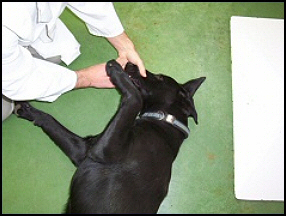
2.CHECK for his heartbeat by placing your ear against the left side of his chest – this is the area where his left elbow touches his chest, immediately behind his left armpit.
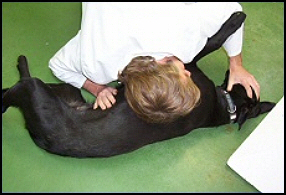
STEP 2: AIRWAY
The second step in CPR is obtaining a patent airway.
1.PULL the tongue out of your pet’s mouth, but be careful to not get bitten.
2.STRAIGHTEN the neck by moving the head to be in line with the neck.
DO NOT HYPEREXTEND IN CASES OF NECK TRAUMA.
3.PERFORM two rescue breaths, by closing the mouth and performing mouth to nose ventilations. IF they continue, then proceed to STEP 3, BREATHING.
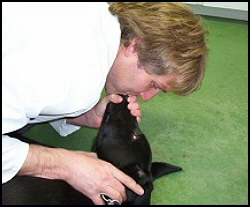
If there are no breaths, then look into the mouth.
4.VISIBLY inspect the mouth and look down the throat for a foreign body. If you see something, reach into the airway and remove it.
5.IF the airway is still not open, attempt HEIMLICH (shown in following steps).
6.TURN your pet upside down, with back against your chest.
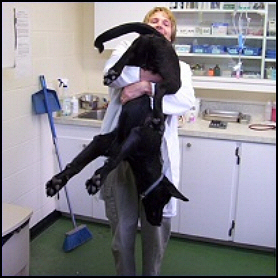
7.WITH both arms, give sharp thrusts to the abdomen.
8.AFTER 5 thrusts, stop and check to see if the object is visible in the airway. If so remove it and give 2 mouth-to-nose rescue breaths. If the breaths do not go in, repeat HEIMLICH.
STEP 3: BREATHING
After achieving a patent airway, perform RESCUE BREATHING.
1.CLOSE your pet’s mouth and breathe directly into his nose until his chest expands. If the chest does not expand then go back to STEP 2 – AIRWAY.
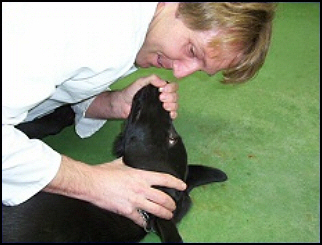
2.VENTILATE at 15 breaths per minute. One BREATH every 4 seconds.
3.PROCEED to STEP 4 – CIRCULATION
STEP 4: CIRCULATION
1.ENSURE there are no major points of bleeding. Control as necessary.
2.GENTLY lay your pet on his right side.
3.LOCATE the heart, which is found on the lower half of the chest on the left side, behind the elbow of the front left leg. Place one hand below the heart to support the chest; place the other hand over the heart.
4.COMPRESS the chest 15 times followed by 2 rescue breaths. 3 compressions every 2 seconds. Compress the chest 1/2 inch for small pets and 1 1/2 inches for large pets.
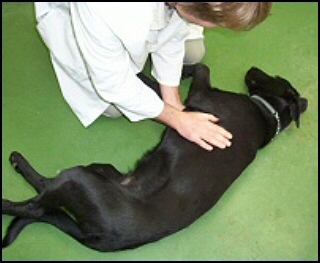
5.EVERY 15 times follow up with 2 rescue breaths.
Continue heart massage compressions and the rescue breathing until you hear a heartbeat and feel regular breathing.
Once your pet is breathing and his heart is beating, call your veterinarian immediately.
With 6 Jack Russell Terriers in my house, this is a good thing to know. Thank you.
What an incredibly patient and tolerant dog Lewis is, to let you hold him upside down. My dogs would have to be genuinely in distress to allow that. =)
Very Helpful! Thanks to You and Lewis!
That was a very helpful article thank you
Dr. Jones and Lewis!
Regards,
Joyce Luciano
I attempted CPR on a neighbors dashound that was on a line and got tangled with another dog and fell through the porch deck steps. The dog was not able to be revived. It may have broken its neck from the drop or have been there too long for the mouth to snout CPR to help. It is definitely worth knowing what to do. Thanks for showing everyone. Thanks Lewis.
This is so essential!
Thank-you for providing such easy steps to follow and with a trooper such as Lewis!
thank you this is very usefull when you have a house full of dogs
I have a question, what do you do with a 150 lb. Leonberger when his airway is obstructed? I can’t pick him up and turn him upside down.
Can I do it like you would on a human??
Did this exactly and it worked beautifully…saved my gorgeous bullmastiff who had a marrowbone lodged in his throat, stopped breathing and his tongue turned blue. What an incredible feeling to see the pink colour flood back in!